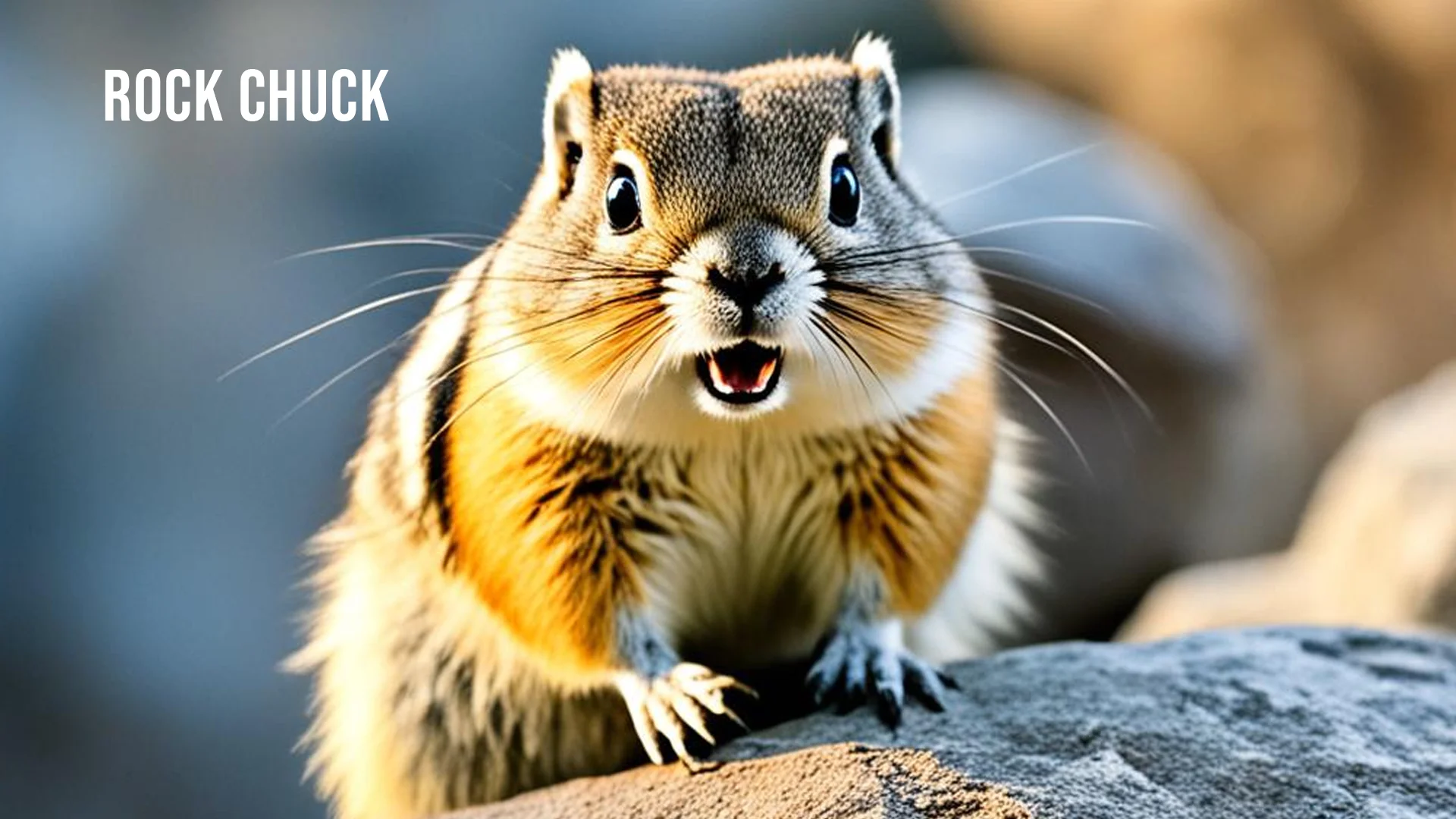Pets
Rock Chuck: Fascinating Facts About This Unique Rodent

The rock chuck, also known as the yellow-bellied marmot (Marmota flaviventris), is a captivating rodent found primarily in the mountainous regions of North America. With their distinctive appearance, social behavior, and unique adaptations, rock chucks play a significant role in their ecosystems. This article delves into the fascinating world of the rock chuck, exploring its habitat, behavior, diet, and more, while also providing insights into its conservation status and relationship with humans.
TRENDING
Crab Spider: Nature’s Camouflaged Predator Explained
Physical Characteristics
Appearance
Rock chucks are medium-sized rodents, typically measuring between 20 to 30 inches in length, including their bushy tails. They usually weigh between 5 to 11 pounds. Their fur is coarse and varies in color from grayish-brown to reddish-brown, with a lighter yellowish underbelly, which gives them their alternative name. Their small, rounded ears and short legs complement their robust body shape.
Lifespan
In the wild, rock chucks can live up to 8 years, although many do not survive that long due to predation and environmental factors. In captivity, they may live even longer with proper care.
Habitat And Range
Geographic Distribution
Rock chucks are primarily found in the western United States and Canada. They inhabit a range of environments, including grasslands, meadows, and rocky slopes in mountainous regions. Their preferred elevation is typically between 5,000 and 12,000 feet.
Burrowing Behavior
These rodents are well-known for their extensive burrowing activities. They create complex tunnel systems that serve as shelters from predators and harsh weather conditions. The burrows can be quite deep, providing a safe haven for them during hibernation.
Diet And Foraging
Herbivorous Diet
Rock chucks are primarily herbivores, feeding on a variety of vegetation. Their diet mainly consists of grasses, wildflowers, and other leafy greens. They have also been known to consume roots and herbs, especially in the late spring and early summer when fresh greens are abundant.
Foraging Behavior
Rock chucks are diurnal, meaning they are active during the day. They spend a significant amount of time foraging for food, especially during the summer months when they are preparing for hibernation. Their foraging habits are essential for maintaining the health of their ecosystem, as they help disperse seeds and promote plant growth.
Social Structure
Social Behavior
Rock chucks are social animals and often live in colonies. They exhibit a complex social structure, which includes a hierarchy among individuals. These colonies are typically made up of several females and a dominant male, with males often fighting for dominance.
Communication
These rodents communicate through a series of vocalizations, including whistles and chirps, to warn each other of potential predators. They are also known for their unique behavior of standing upright on their hind legs to scan the environment for threats.
Reproduction And Life Cycle
Mating Season
Rock chucks typically mate in early spring after emerging from hibernation. The mating season lasts from March to May, with females usually giving birth to a litter of 3 to 6 pups in late spring.
Pup Development
The young are born blind and hairless, relying entirely on their mother for nourishment. They begin to emerge from the burrow around 4 to 6 weeks old and are fully weaned by the time they are about 2 months old. By late summer, they are independent and ready to establish their own territories.
Hibernation
Hibernation Patterns
Rock chucks are true hibernators, entering a state of torpor during the winter months. They typically hibernate from late fall until early spring, during which time their metabolic rate significantly decreases, allowing them to survive on stored body fat.
Importance of Hibernation
Hibernation is crucial for rock chucks as it helps them conserve energy and survive during periods of food scarcity. They often emerge in late March or early April, depending on local weather conditions.
Conservation Status
Threats to Rock Chucks
While rock chucks are not currently listed as endangered, they face several threats that can impact their populations. Habitat loss due to urban development, agriculture, and climate change poses significant risks. Additionally, predation from natural enemies such as coyotes, hawks, and domestic pets can affect their numbers.
Conservation Efforts
Conservation initiatives focused on habitat preservation and public awareness can help ensure the survival of rock chuck populations. By promoting sustainable land-use practices and protecting natural habitats, we can contribute to the conservation of these unique rodents.
Relationship With Humans
Cultural Significance
Rock chucks have held a place in the cultural lore of various Indigenous tribes in North America. They are often featured in stories and teachings, symbolizing strength and resilience.
Ecological Importance
As herbivores, rock chucks play a critical role in their ecosystems. Their foraging activities help promote plant growth, while their burrowing behavior can aerate the soil and create habitats for other species.
Conclusion
The rock chuck is a remarkable rodent with unique adaptations and behaviors that contribute significantly to its ecosystem. Understanding their role in the environment and the challenges they face is crucial for their conservation. By appreciating these fascinating creatures, we can foster a greater awareness of the importance of preserving their habitats for future generations. Whether through their social structures, foraging behaviors, or hibernation patterns, rock chucks continue to intrigue and inspire those who study them.
ALSO READ: Delicious Farfalle Recipes: Easy Bowtie Pasta Dishes To Try
FAQs
What is a rock chuck?
A rock chuck, or yellow-bellied marmot, is a medium-sized rodent native to North America, known for its social behavior and extensive burrowing.
Where do rock chucks live?
Rock chucks primarily inhabit mountainous regions in the western United States and Canada, favoring grassy meadows and rocky slopes.
What do rock chucks eat?
Rock chucks are herbivores, feeding mainly on grasses, wildflowers, and leafy greens, with a diet that varies based on seasonal availability.
How do rock chucks communicate?
Rock chucks communicate through a series of vocalizations, including whistles and chirps, and use body language to signal danger to other members of their colony.
Are rock chucks endangered?
No, rock chucks are not currently endangered, but they face threats such as habitat loss and predation, making conservation efforts important.
Pets
How to Choose One of the Best Dog Harnesses in USA for Your Pet’s Safety and Comfort

Selecting appropriate canine restraint equipment requires careful consideration of biomechanical factors, material durability, and breed-specific anatomical requirements. Modern pet owners increasingly recognize that traditional collar-based restraint systems can cause tracheal damage, cervical spine compression, and behavioral stress responses in dogs. Research conducted by veterinary orthopedic specialists indicates that one of the best dog harnesses in USA demonstrates superior force distribution across the chest and shoulders, reducing concentrated pressure points that commonly occur with collar systems. This comprehensive analysis examines the technical specifications, safety protocols, and performance metrics essential for making informed harness selection decisions.
Understanding Biomechanical Force Distribution
The physics of canine locomotion reveals why harness design significantly impacts pet comfort and safety. When dogs pull against traditional collars, forces concentrate directly on the trachea and cervical vertebrae, creating pressure readings that can exceed 40 pounds per square inch in medium-sized breeds. Harness systems redistribute these forces across broader surface areas, typically reducing peak pressure by 60-75% according to veterinary biomechanics studies.
Front-clip harnesses introduce additional complexity by redirecting pulling forces laterally, which can affect natural gait patterns. Research from canine rehabilitation centers suggests that while front-clip designs effectively reduce pulling behavior, they may create compensatory movement patterns in the shoulders and hindquarters during extended use.
Material Science and Durability Considerations
Modern harness construction utilizes advanced textile engineering principles to balance strength, flexibility, and comfort. Nylon webbing remains the gold standard for load-bearing components, with tensile strength ratings typically ranging from 500 to 1,200 pounds for quality harnesses. However, the weave density and thread count significantly influence both durability and comfort against the dog’s skin.
Padding materials have evolved beyond simple foam inserts to include memory foam composites, gel-infused polymers, and moisture-wicking synthetic fabrics. These advanced materials address common issues like pressure sores, heat retention, and bacterial growth that plagued earlier harness designs.
Breed-Specific Anatomical Adaptations
Different dog breeds present unique anatomical challenges that affect harness fit and function. Brachycephalic breeds like Bulldogs and Pugs require harness designs that accommodate shortened airways and modified chest proportions. Deep-chested breeds such as Greyhounds and Great Danes need harnesses with extended chest panels to prevent interference with natural breathing mechanics.
Working breeds often require reinforced stress points and additional adjustment mechanisms to accommodate seasonal weight fluctuations and muscle development changes. Sporting breeds benefit from harnesses designed with range-of-motion considerations for activities like agility training and field work.
Measurement Protocols and Fit Optimization
Proper harness sizing requires multiple anatomical measurements beyond simple chest circumference. Professional fit protocols include girth measurements at the widest chest point, neck-to-chest length, and shoulder blade positioning assessments. Seasonal adjustments become necessary as coat thickness changes and muscle mass fluctuates with activity levels.
Temperature regulation considerations also influence harness selection, particularly for breeds with dense undercoats or those living in extreme climates. Ventilation channels, moisture-wicking materials, and reflective elements contribute to thermal management during extended wear periods.
CLIC
Pets
Integrating Pet Training into Company Wellness Programs

Work can get busy and stressful, so it is important to find fun ways to help employees feel better. One creative idea is adding dog training to company wellness programs. Imagine coworkers laughing and learning together while they teach dogs new tricks. It’s not just fun- it helps people relax, connect, and work better as a team. And let’s face it, spending time with dogs can make anyone’s day better.
Let’s explore how this simple idea can make a big difference at work.
The Benefits of Incorporating Pet Training
More and more companies are seeing the benefits of full-body and mind wellness programs. Adding pet training to these activities can help create a healthier, more positive workplace.
When employees spend time with animals, it lifts their mood and helps them feel more connected. This kind of experience supports emotional balance and makes it easier for people to handle stress.
Team Building Through Training
Pet training can also be a great way to build stronger teams. During training sessions, employees have to work together, which helps them communicate more effectively.
Teaching a dog takes patience, teamwork, and understanding- skills that are useful on the job, too. Regular practice can create a friendlier and more supportive work environment while helping people build important social skills.
Cost-Effectiveness of Integrating Pet Training
Starting a pet training program can be less expensive than some other wellness programs, like gym memberships or therapy services. Companies can work with local pet trainers, such as OverWatch K9 Academy, to create fun and useful workshops.
These sessions can be designed to fit the company’s needs and keep employees interested. Over time, this kind of program can bring lasting benefits, making it a smart choice for wellness budgets.
Reducing Stress through Hands-On Activities
Employees deal with all kinds of stress at work, like deadlines and tough projects. Doing something active, like dog training, gives them a chance to take a break and relax in a calming space.
Working with a dog can bring joy and a sense of play, helping people feel better and handle tough days more easily. It also gives them a healthy way to let out emotions and feel more balanced.
Implementing a Pet Training Program
Starting a pet training program at work can be pretty easy. First, ask employees if they’re interested and if they have any experience with pets.
Then, set up workshops for different skill levels. Having regular sessions led by skilled trainers helps make sure everyone learns while having fun.
Creating a friendly space where employees can share tips and stories also makes the experience better. Letting them bring their pets to work during these sessions adds to the fun and can turn training into a favorite workplace tradition.
A Win-Win for Employers and Employees
Integrating pet training into corporate wellness programs is not just a trend; it is a transformative approach that can dramatically enhance employee well-being and workplace culture. When employees feel happier and less stressed, productivity naturally improves. Consider partnering with platforms to bring a unique and valuable training experience to your organization. By doing so, you can foster an environment of collaboration, increased morale, and enhanced mental health.
Pets
Ultimate Guide to Choosing the Best Treats for Your Beloved Pet

Every pet owner wants to see their beloved pet happy and healthy. One of the simplest ways to bring a smile to their face is through delicious and nutritious pet treats. But with so many options available, picking the right ones can be overwhelming.
This ultimate guide will help you wade through the choices and ensure you’re making the best decisions for your beloved companion. Keep on reading to learn more.
Understanding Your Pet’s Needs
Just like humans, pets have unique dietary requirements. Understanding these needs is crucial when selecting healthy pet treats. Here are some factors to consider:
- Age
- Weight
- Health Conditions
- Type
Types of Pet Treats
In the vast market for pet snacks, there are a few main categories. Each type has its pros and cons:
Dog Treats
Dog treats come in many types like biscuits, jerky, and chewy sticks. Pick ones made with good ingredients and not too many calories. Some help clean teeth too.
Cat Treats
Cats like treats that are crunchy or meaty. Choose treats with healthy stuff like vitamins and protein. Good treats help keep your cat strong.
Training Treats
Training treats are small and soft. They help pets learn by giving quick rewards. Use ones that are low in calories so your pet stays healthy.
Ingredients Matter
When browsing for pet treats, always read the label. High-quality treats are typically made with real meat, whole grains, and vegetables. Be wary of treats containing fillers like corn or soy. Opt for:
- Natural ingredients
- No artificial preservatives
- Animal protein sources, like chicken or fish
- Added vitamins and minerals
Homemade Treats: A Personal Touch
If you enjoy spending time in the kitchen, consider making homemade pet treats. This allows you to control every ingredient. Some easy recipes involve simple components like peanut butter, pumpkin, and oats. Just make sure any ingredients you use are safe for your pet.
Store-Bought Treasures
Purchasing dog treats and cat treats from stores can be convenient. Look for reputable brands that prioritize quality. Check for customer reviews and consider a brand’s reputation before purchasing. Local pet stores often have knowledgeable staff who can recommend the best options.
Rewarding with Purpose
Using treats is about more than just enjoyment; it’s bonding time and training reinforcement. Effective use of treats can:
- Strengthen your companionship
- Encourage good behavior
- Assist in training new commands
Remember to use them wisely! Moderation is key, so avoid overloading your pet with snacks.
Choosing the Right Treats
In the end, selecting the right treats boils down to understanding your pet’s individual preferences and needs. Make sure to balance their health and enjoyment by taking the time to choose wisely. By focusing on quality ingredients and considering your pet’s specific requirements, you’ll be well on your way to making treat time a truly delightful experience.
Make Treat Time Special for Your Beloved Pet
At the end of the day, knowing your beloved pet is getting the best of the best in snacks makes all the difference. Whether you opt for store-bought solutions or craft delightful homemade tasty bites, the joy it brings your beloved best friend is priceless. Treat them with love and care!
-

 Law6 months ago
Law6 months agoProtect Your Vehicle with These Smart Motor Insurance Strategies
-

 Business2 years ago
Business2 years agoWhat is O Farming: How to Make Money Online and Its Start-Up Benefits
-

 Entertainment2 years ago
Entertainment2 years agoSandra Orlow: Exploring the Life and Legacy of a Cultural Icon
-

 General1 year ago
General1 year agoBaby Alien Fan Bus: Watch Parts 2 & 3 on Twitter, Reddit!
-

 Entertainment6 months ago
Entertainment6 months agoExplore The Kristen Archives: A Treasure Trove Of Stories & More
-

 Technology2 years ago
Technology2 years agoGeekzilla Radio: Your Portal to the Ultimate Geeky Adventure!
-

 General1 year ago
General1 year agoDiana Nyad & Bart Springtime: A Swim to Success
-

 Business2 years ago
Business2 years agoTex9.Net Crypto: Fast, Secure International Money Transfers with Competitive Rates
